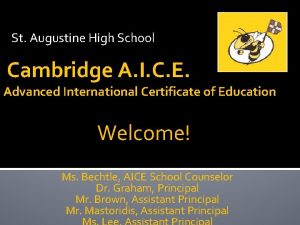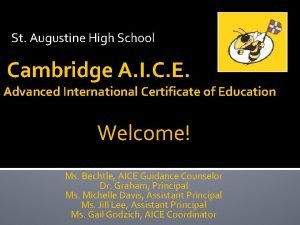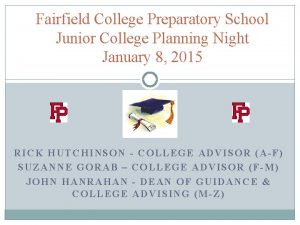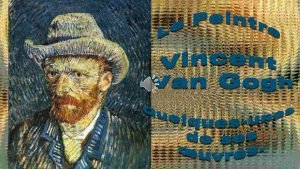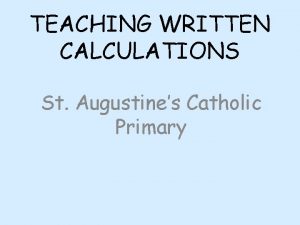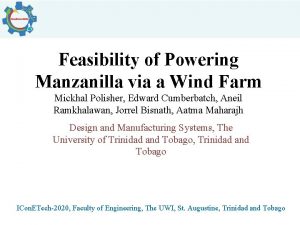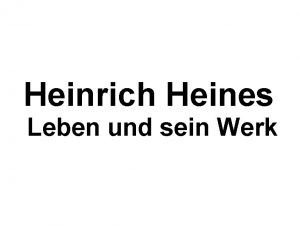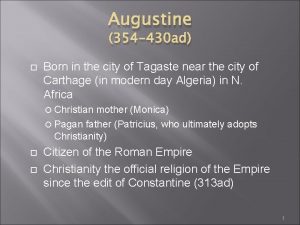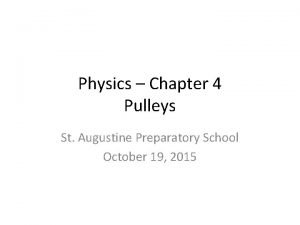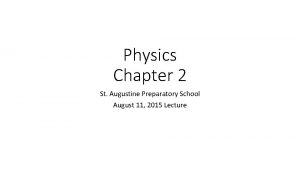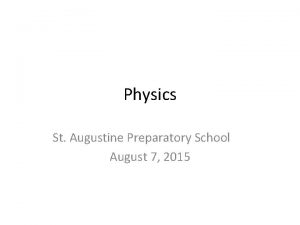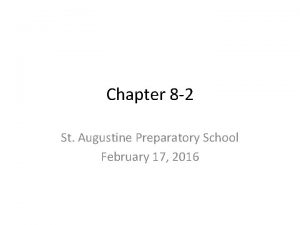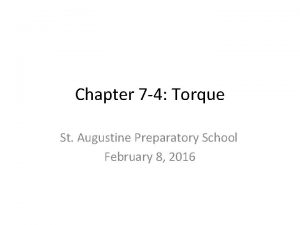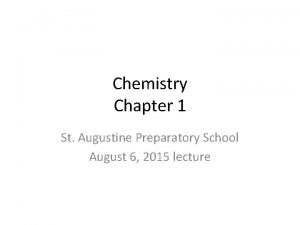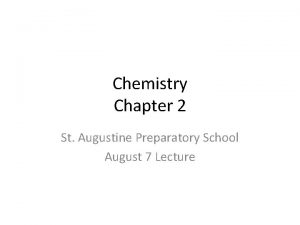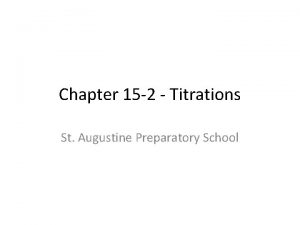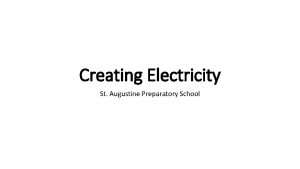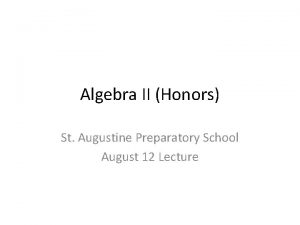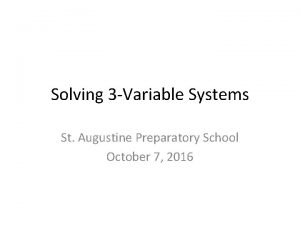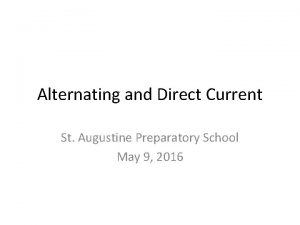Physics Chapter 1 St Augustine Preparatory School The

















- Slides: 17

Physics Chapter 1 St. Augustine Preparatory School

The Scientific Method • Physics follows the scientific method 1) Make observations and collect data - This will allow you to formulate a question 2) Create and test a hypothesis through controlled experimentation 3) Interpret results and revise hypothesis if necessary 4) State conclusions in a form that can be evaluated by others

Using Models • Physics can often be very complex, so simplified models can be used • System – the interacting components considered to be necessary for the purpose of the study

• Example: Improving the fuel efficiency of a vehicle. Things that could potentially matter:

• To run a legitimate and effective study, we cannot change all of these variables at once. • We must also run a “control” group that has only changed one variable. • The best physics models can make predictions in new situations

If we drop a roll of tape and a piece of paper at the same time, which one is going to hit the ground first? What about in a vacuum? (youtube video) What can we conclude from both of these trials?

SI Units In 1960, an international committee decided on a system of standards and units, known as SI units (Systeme International d’Unites). We have 7 base units in SI: 1) meter 2) kilogram 3) second 4) ampere 5) candela 6) kelvin and 7) mole

Random Facts: Unit Original Standard Current Standard Meter (length) 1/10 000 th the distance from the equator to the North Pole The distance travelled by light in a vacuum in 3. 33564095 x 10 -9 s Kilogram (mass) Mass of 0. 001 cubic meters of water The mass of a specific platinum-iridium alloy cylinder Second (time) (1/60)(1/24) = 0. 000 011 574 average solar days 9 192 631 770 times the period of a radio wave emitted from cesium-133 atom

These 7 cannot explain everything though… These units have been combined to create what we call “derived units” Example: Velocity is measured in m/s (meters per second) However, force is measured in N (Newton’s)

Prefixes for units You are required to know the following prefixes for units: a) Pico (p): 10 -12 g) kilo(k): 103 b) Nano(n): 10 -9 h) mega(M): 106 c) Micro(μ): 10 -6 i) giga(G): 109 d) Milli(m): 10 -3 j) tetra(T): 1012 e) Centi(c): 10 -2 f) deci(d): 10 -1

Conversions • Example: Convert 162000 g to Mg • Example: Convert 1312 km to meters

Practice conversions 1) 10 kilograms in megagrams 2) 0. 00342 kilometers in centimeters 3) 132. 5 cm in decimeters 4) 132 millimeters to micrometers 5) 262, 523 micrometers in meters 6) 2329 picograms to milligrams

Significant Figures • Significant figures (also called significant digits) are important as they indicate the precision of a measurement • Page 18 in your textbook has the rules for determining the amount of significant figures in a number

Practice a) b) c) d) e) f) g) 1. 0303 m 2. 50 kg 0. 00032 s 3. 0 x 102 mm 45 s 40 s 2. 2830 km h) 1000 kg i) 6. 723 m j) 4. 200 J

Rules for addition and subtraction • When adding and subtracting numbers, the final answer will have the same number of decimal places as the number used in the addition/subtraction that had the least number of decimal places. • Examples: 121. 03 + 5. 8 = 125 – 5. 5 =

Rules for multiplication and division • When multiplying and dividing, the final answer must have the same number of significant figures as the number used that had the least number of significant digits. Examples: a) 24. 0 x 1. 5 = b) 36. 00/2. 00 =

Practice 1) 2) 3) 4) 5) 6) 7) 8) 97. 3 + 5. 85 = 122. 3 – 0. 52 = (124. 2)(2. 1) = (2 x 102)(1. 232) = 24. 56 / 2. 3213 = 2. 02 x 106 + 1. 3 x 105 = 1. 000 + 2. 01 + 3. 523 + 2. 6 = (1. 20)(2. 212)(0. 0035) =
 St augustine school cambridge
St augustine school cambridge St augustine school cambridge
St augustine school cambridge Lutz preparatory school lottery
Lutz preparatory school lottery James weldon johnson college preparatory middle school
James weldon johnson college preparatory middle school Akron preparatory school
Akron preparatory school Northdene preparatory school
Northdene preparatory school Fairfield college preparatory school
Fairfield college preparatory school Augustine roulin
Augustine roulin St augustine's rc church
St augustine's rc church Windfinder st augustine
Windfinder st augustine Mysterion sacramentum
Mysterion sacramentum Wo wird einst des wandermüden letzte ruhestätte sein
Wo wird einst des wandermüden letzte ruhestätte sein St augustine deaf history
St augustine deaf history St augustine
St augustine Shon augustine
Shon augustine Noah augustine
Noah augustine Jacques murphy pagnol
Jacques murphy pagnol Augustine 354-430 ad
Augustine 354-430 ad
